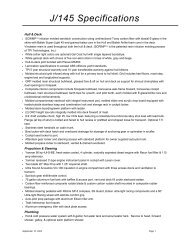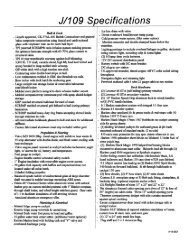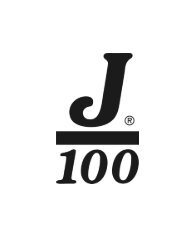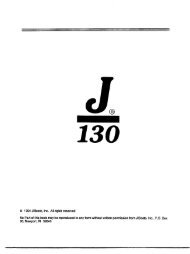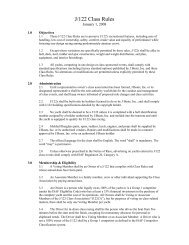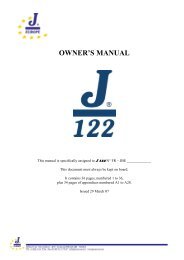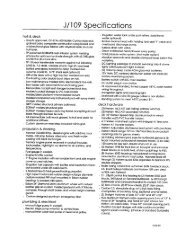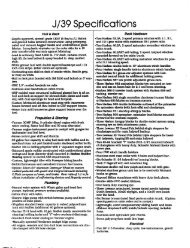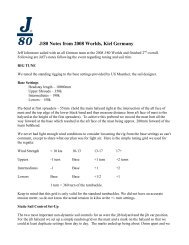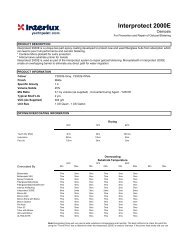WindCheck Template - J/Owners
WindCheck Template - J/Owners
WindCheck Template - J/Owners
You also want an ePaper? Increase the reach of your titles
YUMPU automatically turns print PDFs into web optimized ePapers that Google loves.
A Sprit for the J/44<br />
By Scott Dinhofer<br />
In an effort to breathe new life into our J/44 Brown-eyed Girl<br />
(USA 44007) we embarked this year on installing a bowsprit and<br />
asymmetrical sails. Bill Ketcham, the owner of J/44 Maxine (USA<br />
83000) and I worked on this together. The requirements were<br />
simple deployment, cost effectiveness and robust engineering. I<br />
worked on the feasibility study with Alan Johnstone of J/Boats.<br />
The starting point was essentially a J/133-sized spinnaker. After<br />
consulting with numerous sailmakers and running a few trial IRC<br />
certificates, we came up with a sprit and spinnaker size that we<br />
felt was optimal.<br />
We achieved a spinnaker with 30 percent greater area and an<br />
equally longer luff - with no penalty under IRC. Of course, this<br />
means that we can no longer pole back. We feel that if we were to<br />
use this in distance races or achieved a one-design class conversion,<br />
it wouldn’t be a factor. It’s our belief that we’d gain on the standard<br />
rig in light, pole-on-the-headstay reaching conditions, and begin<br />
to lose out somewhere in the mid-teens, as traditional boats would<br />
be able to pole back. We also believe we’ll gain ability to handle<br />
the boat in true heavy air conditions without wiping out.<br />
The execution of the sprit design by Goetz Custom Boats of<br />
Bristol, RI was flawless. They engineered a forward ring on a<br />
bracket that’s through-bolted to the stem fitting on the bow. The<br />
robust carbon pole sits in this collar with the butt end affixed to<br />
two pad eyes on deck. The sprit has both a rear unloaded storage<br />
position and a forward deployed position tied into the boat structurally<br />
via an under-deck L-bracket bolted to the forward bulkhead.<br />
We’ve had three opportunities to test this configuration to<br />
date: the Vineyard Race, the Stamford-Denmark Friendship Race<br />
and the Indian Harbor Yacht Club Gearbuster. We started the<br />
Vineyard Race with a code zero flying from the end of the pole.<br />
We saw a fair amount of lateral flex in the pole and slight upward<br />
flex. We think this was about the heaviest loads we would see, as<br />
it was tight for a code zero and was blowing around 17.<br />
Given the nature of this year’s Vineyard Race, we ended up<br />
flying various genoas and our jib top more than anything. We utilized<br />
the sprit again for the code zero between the tower and<br />
Block Island. I’d like to think this was our “secret weapon,” as we<br />
won our class! The only issue we had was the bow piece bent<br />
quite a bit and we sent it back to GMT Composites in Bristol for<br />
reengineering. The folks at GMT, led by David Schwartz, were<br />
very helpful and stood by their work. We’ve since bolted a much<br />
heavier piece to the bow and haven’t seen those issues since.<br />
We sailed against two other J/44s in the Friendship Race,<br />
and beat them by a bit on the first three-mile windward leg, so we<br />
didn’t see a side-by-side comparison with the symmetrical spinnaker.<br />
We flew our largest sail, the 2A runner, on the first downwind<br />
where it got extremely light and were able to keep the sail<br />
full and drawing the entire time.<br />
photoboat.com<br />
After a fetch and a strong southerly filling in, we rounded<br />
Bell 14 off Lloyd’s Point about six boatlengths behind Steve Benjamin’s<br />
High Noon. Our sail chart had us on the edge between the<br />
3A reaching spinnaker and the code zero. We opted for the 3A so<br />
we could start to learn our angles. It turned out to be the right<br />
call. We gained on High Noon in a 14-knot southerly, finishing<br />
overlapped with them. We won our class in this race, a first for<br />
the Brown-eyed Girl team!<br />
The Gearbuster started in a light but building westerly (255-<br />
265) and our course was 94 to the Stratford Shoal tower. This<br />
would be a good test in a run. Our competition was a number of<br />
well-sailed boats: a J/122, J/133, J/37 and Bombardino, a Santa<br />
Cruz 52. The wind built, and most of this 22-mile run was sailed<br />
in 12-14 knots - conditions where we thought we’d lose out to a<br />
symmetrical boat on rating.<br />
We sailed the shifts and pressure lanes, jibing about eight<br />
times, and we lost the J/122 on a shift or missed pressure. We<br />
pressed down and appeared to hold our time on Bombardino and<br />
the J/133. We later learned that our North Sails designer, aboard<br />
the J/122, felt we’d consistently sailed at too high an angle, but<br />
given that we finished second we feel good about the boat’s ability<br />
to sail with the new kites. ✦<br />
Scott Dinhofer lives in Chappaqua, NY. Racing under the burgees of<br />
Indian Harbor Yacht Club and the New York Yacht Club, Browneyed<br />
Girl (USA 44007) was the first IMS finisher in the 2001<br />
Around Long Island Regatta, and won the J/44 class in the 2006<br />
Newport-to-Bermuda Race. “In the 18 years since the first J/44 was<br />
built, nothing has come along to unseat it in this size range as an offshore<br />
racer that can truly be cruised comfortably and raced around<br />
the buoys,”says Dinhohofer. The team’s online at: usa44007.com.<br />
50 December 2007 <strong>WindCheck</strong> windchecklis.com



